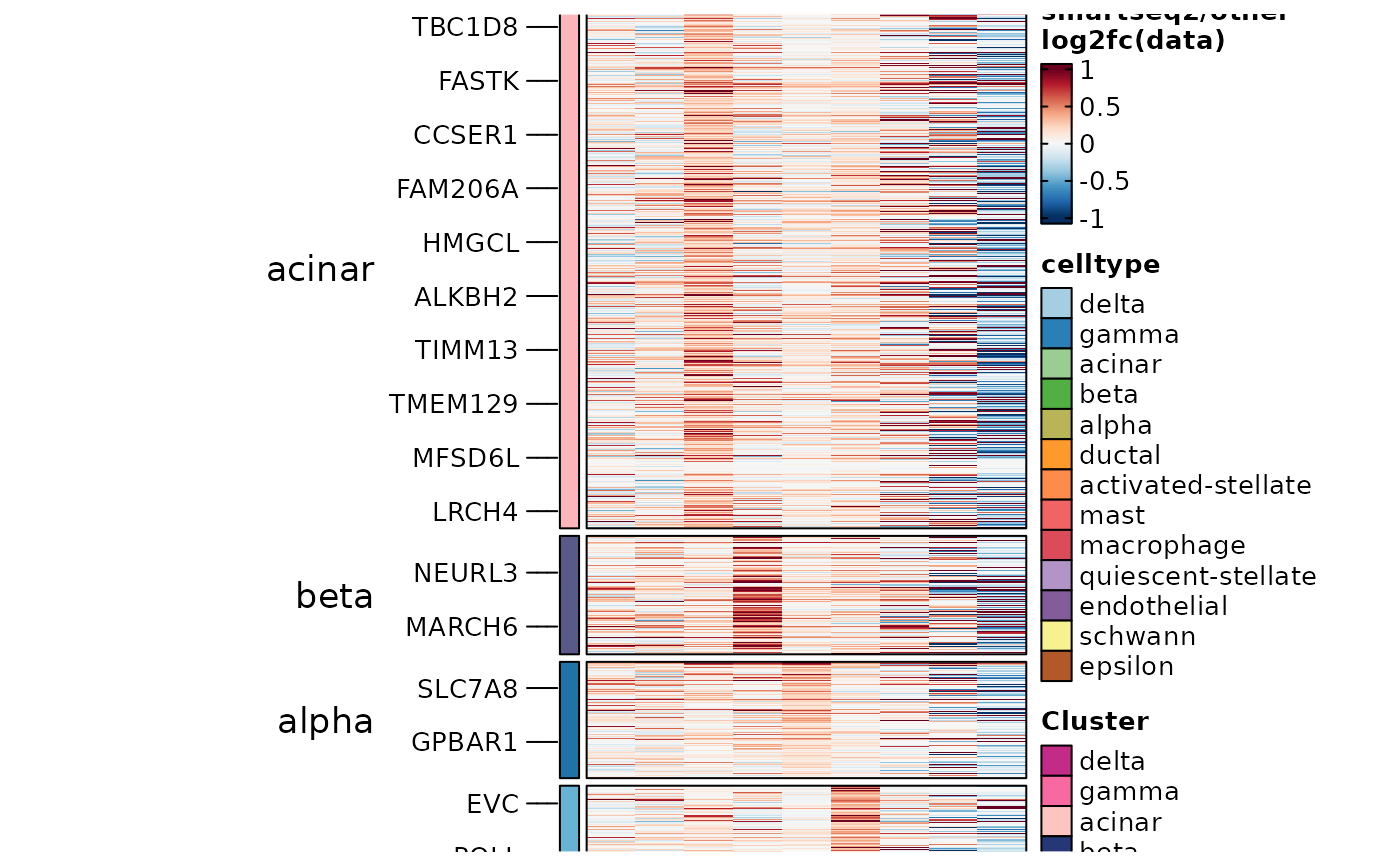This function utilizes the Seurat package to perform a differential expression (DE) test on gene expression data. Users have the flexibility to specify custom cell groups, marker types, and various options for DE analysis.
Usage
RunDEtest(
srt,
group_by = NULL,
group1 = NULL,
group2 = NULL,
cells1 = NULL,
cells2 = NULL,
features = NULL,
markers_type = c("all", "paired", "conserved", "disturbed"),
grouping.var = NULL,
meta.method = c("maximump", "minimump", "wilkinsonp", "meanp", "sump", "votep"),
test.use = "wilcox",
only.pos = TRUE,
fc.threshold = 1.5,
base = 2,
pseudocount.use = 1,
mean.fxn = NULL,
min.pct = 0.1,
min.diff.pct = -Inf,
max.cells.per.ident = Inf,
latent.vars = NULL,
min.cells.feature = 3,
min.cells.group = 3,
norm.method = "LogNormalize",
p.adjust.method = "bonferroni",
layer = "data",
assay = NULL,
seed = 11,
verbose = TRUE,
cores = 1,
...
)Arguments
- srt
A Seurat object.
- group_by
A grouping variable in the dataset to define the groups or conditions for the differential test. If not provided, the function uses the "active.ident" variable in the Seurat object.
- group1
A vector of cell IDs or a character vector specifying the cells that belong to the first group. If both group_by and group1 are provided, group1 takes precedence.
- group2
A vector of cell IDs or a character vector specifying the cells that belong to the second group. This parameter is only used when group_by or group1 is provided.
- cells1
A vector of cell IDs specifying the cells that belong to group1. If provided, group1 is ignored.
- cells2
A vector of cell IDs specifying the cells that belong to group2. This parameter is only used when cells1 is provided.
- features
A vector of gene names specifying the features to consider for the differential test. If not provided, all features in the dataset are considered.
- markers_type
A character value specifying the type of markers to find. Possible values are "all", "paired", "conserved", and "disturbed".
- grouping.var
A character value specifying the grouping variable for finding conserved or disturbed markers. This parameter is only used when markers_type is "conserved" or "disturbed".
- meta.method
A character value specifying the method to use for combining p-values in the conserved markers test. Possible values are "maximump", "minimump", "wilkinsonp", "meanp", "sump", and "votep".
- test.use
Denotes which test to use. Available options are:
"wilcox" : Identifies differentially expressed genes between two groups of cells using a Wilcoxon Rank Sum test (default); will use a fast implementation by Presto if installed
"wilcox_limma" : Identifies differentially expressed genes between two groups of cells using the limma implementation of the Wilcoxon Rank Sum test; set this option to reproduce results from Seurat v4
"bimod" : Likelihood-ratio test for single cell gene expression, (McDavid et al., Bioinformatics, 2013)
"roc" : Identifies 'markers' of gene expression using ROC analysis. For each gene, evaluates (using AUC) a classifier built on that gene alone, to classify between two groups of cells. An AUC value of 1 means that expression values for this gene alone can perfectly classify the two groupings (i.e. Each of the cells in cells.1 exhibit a higher level than each of the cells in cells.2). An AUC value of 0 also means there is perfect classification, but in the other direction. A value of 0.5 implies that the gene has no predictive power to classify the two groups. Returns a 'predictive power' (abs(AUC-0.5) * 2) ranked matrix of putative differentially expressed genes.
"t" : Identify differentially expressed genes between two groups of cells using the Student's t-test.
"negbinom" : Identifies differentially expressed genes between two groups of cells using a negative binomial generalized linear model. Use only for UMI-based datasets
"poisson" : Identifies differentially expressed genes between two groups of cells using a poisson generalized linear model. Use only for UMI-based datasets
"LR" : Uses a logistic regression framework to determine differentially expressed genes. Constructs a logistic regression model predicting group membership based on each feature individually and compares this to a null model with a likelihood ratio test.
"MAST" : Identifies differentially expressed genes between two groups of cells using a hurdle model tailored to scRNA-seq data. Utilizes the MAST package to run the DE testing.
"DESeq2" : Identifies differentially expressed genes between two groups of cells based on a model using DESeq2 which uses a negative binomial distribution (Love et al, Genome Biology, 2014).This test does not support pre-filtering of genes based on average difference (or percent detection rate) between cell groups. However, genes may be pre-filtered based on their minimum detection rate (min.pct) across both cell groups. To use this method, please install DESeq2, using the instructions at https://bioconductor.org/packages/release/bioc/html/DESeq2.html
- only.pos
Only return positive markers (FALSE by default)
- fc.threshold
A numeric value used to filter genes for testing based on their average fold change between/among the two groups. Default is
1.5.- base
The base with respect to which logarithms are computed.
- pseudocount.use
Pseudocount to add to averaged expression values when calculating logFC. 1 by default.
- mean.fxn
Function to use for fold change or average difference calculation. The default depends on the the value of
fc.slot:"counts" : difference in the log of the mean counts, with pseudocount.
"data" : difference in the log of the average exponentiated data, with pseudocount. This adjusts for differences in sequencing depth between cells, and assumes that "data" has been log-normalized.
"scale.data" : difference in the means of scale.data.
- min.pct
only test genes that are detected in a minimum fraction of min.pct cells in either of the two populations. Meant to speed up the function by not testing genes that are very infrequently expressed. Default is 0.01
- min.diff.pct
only test genes that show a minimum difference in the fraction of detection between the two groups. Set to -Inf by default
- max.cells.per.ident
Down sample each identity class to a max number. Default is no downsampling. Not activated by default (set to Inf)
- latent.vars
Variables to test, used only when
test.useis one of 'LR', 'negbinom', 'poisson', or 'MAST'- min.cells.feature
Minimum number of cells expressing the feature in at least one of the two groups, currently only used for poisson and negative binomial tests
- min.cells.group
Minimum number of cells in one of the groups
- norm.method
Normalization method for fold change calculation when layer is 'data'. Default is
"LogNormalize".- p.adjust.method
A character value specifying the method to use for adjusting p-values. Default is
"bonferroni".- layer
The layer used.
- assay
Assay to use in differential expression testing
- seed
An integer value specifying the seed. Default is
11.- verbose
Print a progress bar once expression testing begins
- cores
The number of cores to use for parallelization with foreach::foreach. Default is
1.- ...
Additional arguments to pass to the Seurat::FindMarkers function.
Examples
data(pancreas_sub)
pancreas_sub <- standard_scop(pancreas_sub)
#> StandardPC_ 1
#> Positive: Aplp1, Cpe, Gnas, Fam183b, Map1b, Hmgn3, Pcsk1n, Chga, Tuba1a, Bex2
#> Syt13, Isl1, 1700086L19Rik, Pax6, Chgb, Scgn, Rbp4, Scg3, Gch1, Camk2n1
#> Cryba2, Pcsk2, Pyy, Tspan7, Mafb, Hist3h2ba, Dbpht2, Abcc8, Rap1b, Slc38a5
#> Negative: Spp1, Anxa2, Sparc, Dbi, 1700011H14Rik, Wfdc2, Gsta3, Adamts1, Clu, Mgst1
#> Bicc1, Ldha, Vim, Cldn3, Cyr61, Rps2, Mt1, Ptn, Phgdh, Nudt19
#> Smtnl2, Smco4, Habp2, Mt2, Col18a1, Rpl12, Galk1, Cldn10, Acot1, Ccnd1
#> StandardPC_ 2
#> Positive: Rbp4, Tagln2, Tuba1b, Fkbp2, Pyy, Pcsk2, Iapp, Tmem27, Meis2, Tubb4b
#> Pcsk1n, Dbpht2, Rap1b, Dynll1, Tubb2a, Sdf2l1, Scgn, 1700086L19Rik, Scg2, Abcc8
#> Atp1b1, Hspa5, Fam183b, Papss2, Slc38a5, Scg3, Mageh1, Tspan7, Ppp1r1a, Ociad2
#> Negative: Neurog3, Btbd17, Gadd45a, Ppp1r14a, Neurod2, Sox4, Smarcd2, Mdk, Pax4, Btg2
#> Sult2b1, Hes6, Grasp, Igfbpl1, Gpx2, Cbfa2t3, Foxa3, Shf, Mfng, Tmsb4x
#> Amotl2, Gdpd1, Cdc14b, Epb42, Rcor2, Cotl1, Upk3bl, Rbfox3, Cldn6, Cer1
#> StandardPC_ 3
#> Positive: Nusap1, Top2a, Birc5, Aurkb, Cdca8, Pbk, Mki67, Tpx2, Plk1, Ccnb1
#> 2810417H13Rik, Incenp, Cenpf, Ccna2, Prc1, Racgap1, Cdk1, Aurka, Cdca3, Hmmr
#> Spc24, Kif23, Sgol1, Cenpe, Cdc20, Hist1h1b, Cdca2, Mxd3, Kif22, Ska1
#> Negative: Anxa5, Pdzk1ip1, Acot1, Tpm1, Anxa2, Dcdc2a, Capg, Sparc, Ttr, Pamr1
#> Clu, Cxcl12, Ndrg2, Hnf1aos1, Gas6, Gsta3, Krt18, Ces1d, Atp1b1, Muc1
#> Hhex, Acadm, Spp1, Enpp2, Bcl2l14, Sat1, Smtnl2, 1700011H14Rik, Tgm2, Fam159a
#> StandardPC_ 4
#> Positive: Glud1, Tm4sf4, Akr1c19, Cldn4, Runx1t1, Fev, Pou3f4, Gm43861, Pgrmc1, Arx
#> Cd200, Lrpprc, Hmgn3, Ppp1r14c, Pam, Etv1, Tsc22d1, Slc25a5, Akap17b, Pgf
#> Fam43a, Emb, Jun, Krt8, Dnajc12, Mid1ip1, Ids, Rgs17, Uchl1, Alcam
#> Negative: Ins2, Ins1, Ppp1r1a, Nnat, Calr, Sytl4, Sdf2l1, Iapp, Pdia6, Mapt
#> G6pc2, C2cd4b, Npy, Gng12, P2ry1, Ero1lb, Adra2a, Papss2, Arhgap36, Fam151a
#> Dlk1, Creld2, Gip, Tmem215, Gm27033, Cntfr, Prss53, C2cd4a, Lyve1, Ociad2
#> StandardPC_ 5
#> Positive: Pdx1, Nkx6-1, Npepl1, Cldn4, Cryba2, Fev, Jun, Chgb, Gng12, Adra2a
#> Mnx1, Sytl4, Pdk3, Gm27033, Nnat, Chga, Ins2, 1110012L19Rik, Enho, Krt7
#> Mlxipl, Tmsb10, Flrt1, Pax4, Tubb3, Prrg2, Gars, Frzb, BC023829, Gm2694
#> Negative: Irx2, Irx1, Gcg, Ctxn2, Tmem27, Ctsz, Tmsb15l, Nap1l5, Pou6f2, Gria2
#> Ghrl, Peg10, Smarca1, Arx, Lrpap1, Rgs4, Ttr, Gast, Tmsb15b2, Serpina1b
#> Slc16a10, Wnk3, Ly6e, Auts2, Sct, Arg1, Dusp10, Sphkap, Dock11, Edn3
pancreas_sub <- RunDEtest(
pancreas_sub,
group_by = "SubCellType"
)
#> ⠙ [2025-12-05 08:51:56] Running [1/8] Processing: Ductal ETA: 1s
#> ✔ [2025-12-05 08:51:56] Completed 8 tasks in 1.2s
#>
AllMarkers <- dplyr::filter(
pancreas_sub@tools$DEtest_SubCellType$AllMarkers_wilcox,
p_val_adj < 0.05 & avg_log2FC > 1
)
ht1 <- GroupHeatmap(
pancreas_sub,
features = AllMarkers$gene,
feature_split = AllMarkers$group1,
group.by = "SubCellType"
)
#> 'magick' package is suggested to install to give better rasterization.
#>
#> Set `ht_opt$message = FALSE` to turn off this message.
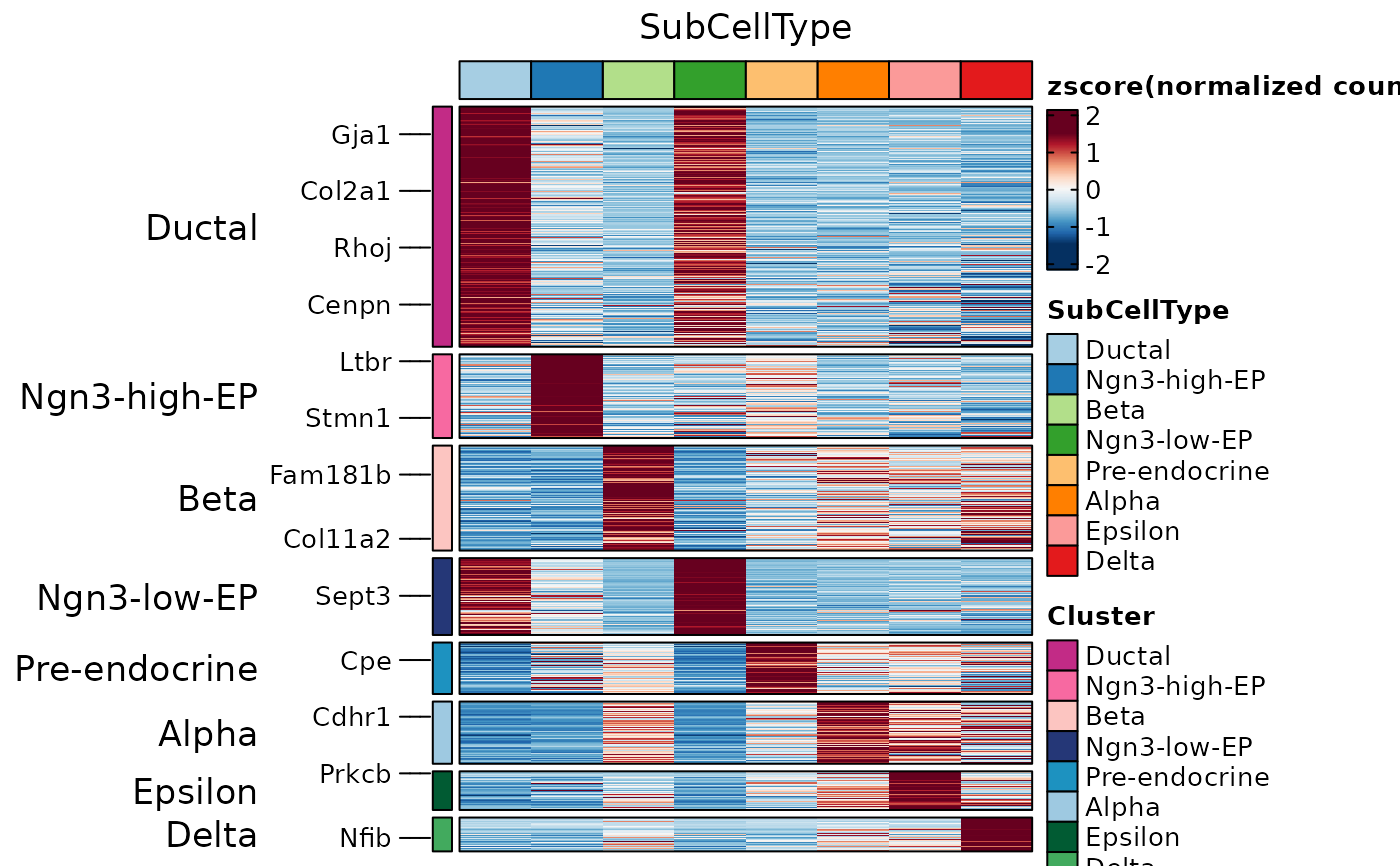 ht1$plot
ht1$plot
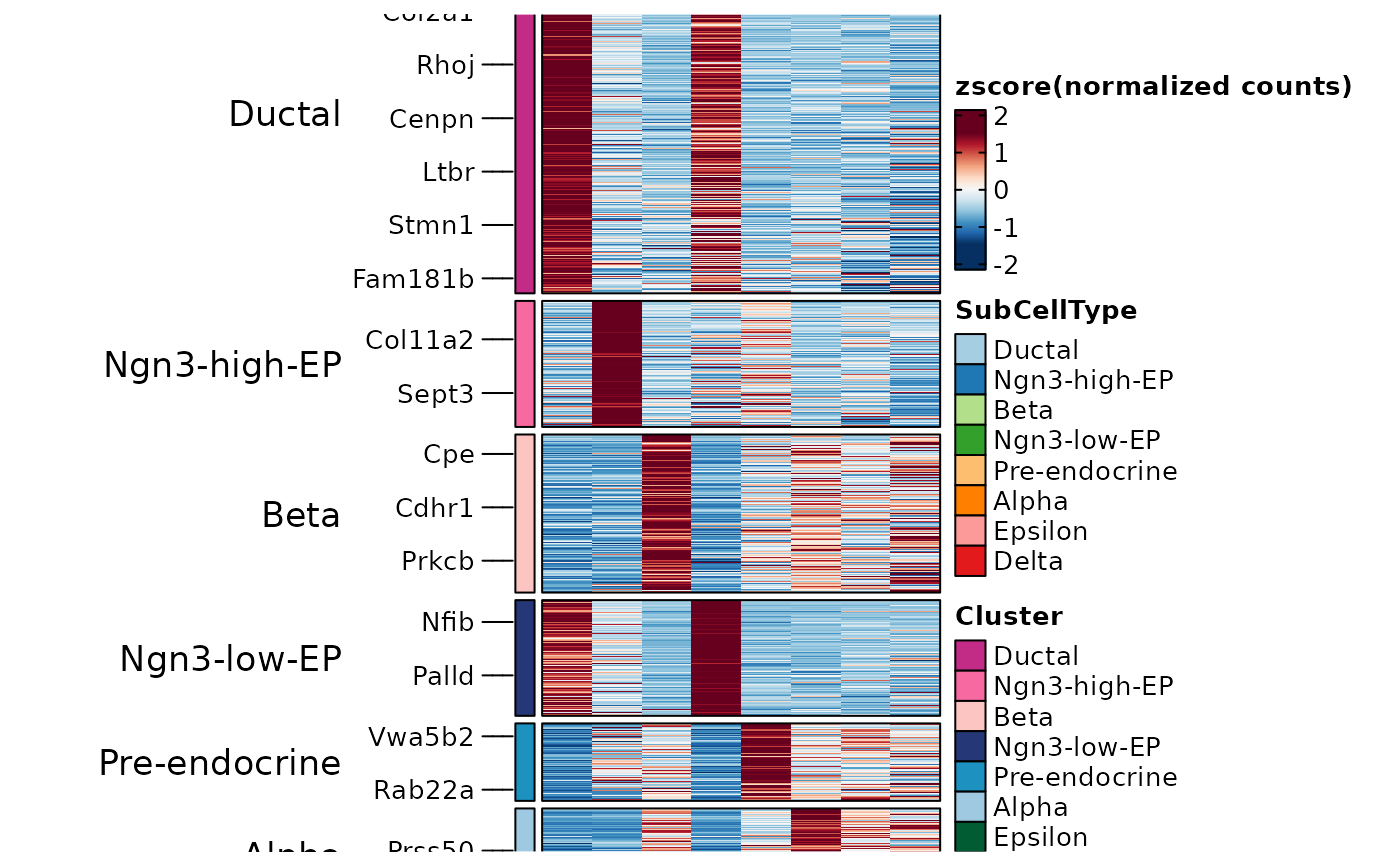 TopMarkers <- AllMarkers |>
dplyr::group_by(gene) |>
dplyr::top_n(1, avg_log2FC) |>
dplyr::group_by(group1) |>
dplyr::top_n(3, avg_log2FC)
ht2 <- GroupHeatmap(
pancreas_sub,
features = TopMarkers$gene,
feature_split = TopMarkers$group1,
group.by = "SubCellType",
show_row_names = TRUE
)
#> 'magick' package is suggested to install to give better rasterization.
#>
#> Set `ht_opt$message = FALSE` to turn off this message.
TopMarkers <- AllMarkers |>
dplyr::group_by(gene) |>
dplyr::top_n(1, avg_log2FC) |>
dplyr::group_by(group1) |>
dplyr::top_n(3, avg_log2FC)
ht2 <- GroupHeatmap(
pancreas_sub,
features = TopMarkers$gene,
feature_split = TopMarkers$group1,
group.by = "SubCellType",
show_row_names = TRUE
)
#> 'magick' package is suggested to install to give better rasterization.
#>
#> Set `ht_opt$message = FALSE` to turn off this message.
 ht2$plot
ht2$plot
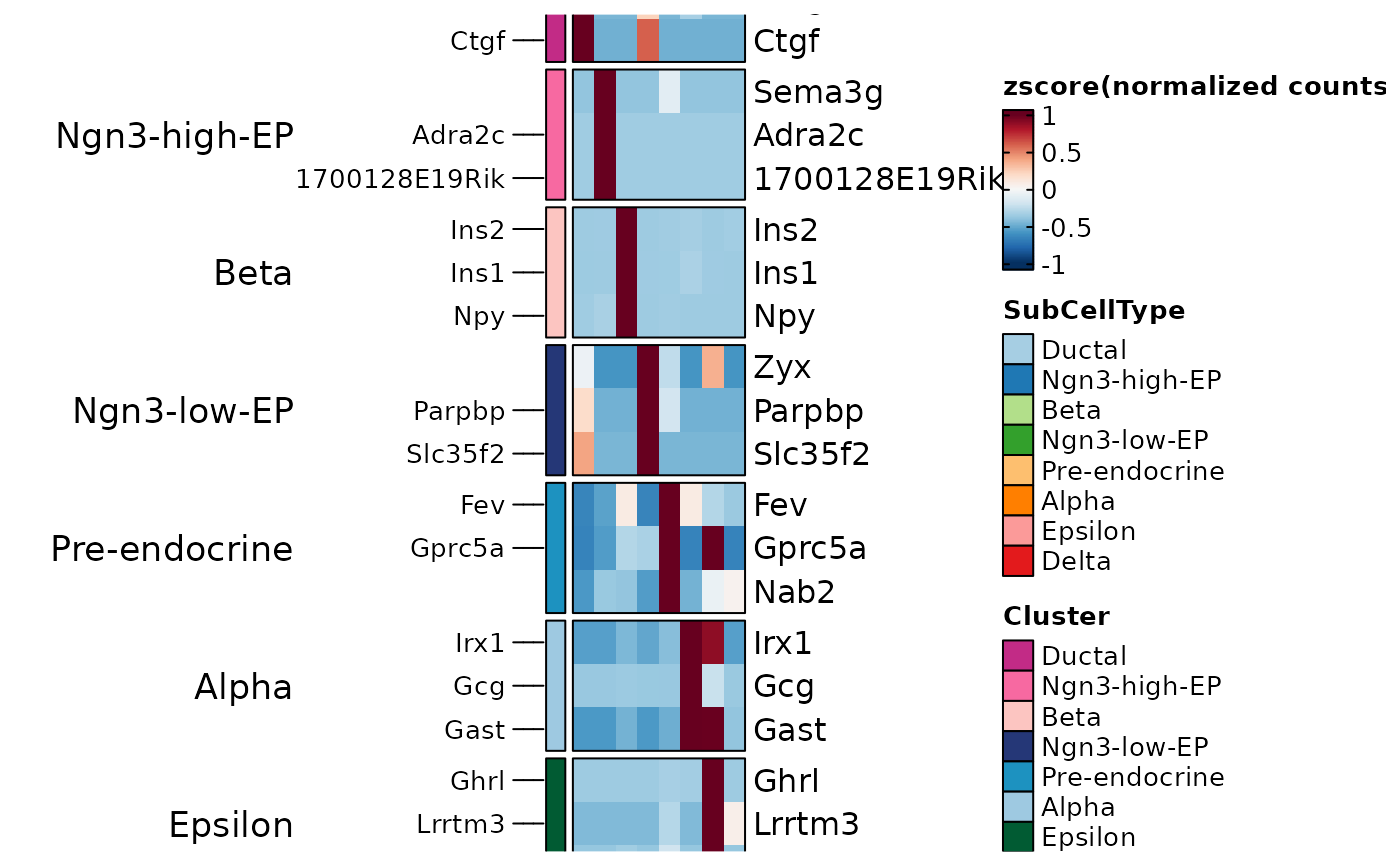 pancreas_sub <- RunDEtest(
pancreas_sub,
group_by = "SubCellType",
markers_type = "paired",
cores = 2
)
#> ⠙ [2025-12-05 08:52:05] Running [28/56] Processing: 1, 3, 5, 7, 9, 11, 13, 15, …
#> ✔ [2025-12-05 08:52:05] Completed 56 tasks in 3.4s
#>
PairedMarkers <- dplyr::filter(
pancreas_sub@tools$DEtest_SubCellType$PairedMarkers_wilcox,
p_val_adj < 0.05 & avg_log2FC > 1
)
ht3 <- GroupHeatmap(
pancreas_sub,
features = PairedMarkers$gene,
feature_split = PairedMarkers$group1,
group.by = "SubCellType"
)
#> 'magick' package is suggested to install to give better rasterization.
#>
#> Set `ht_opt$message = FALSE` to turn off this message.
pancreas_sub <- RunDEtest(
pancreas_sub,
group_by = "SubCellType",
markers_type = "paired",
cores = 2
)
#> ⠙ [2025-12-05 08:52:05] Running [28/56] Processing: 1, 3, 5, 7, 9, 11, 13, 15, …
#> ✔ [2025-12-05 08:52:05] Completed 56 tasks in 3.4s
#>
PairedMarkers <- dplyr::filter(
pancreas_sub@tools$DEtest_SubCellType$PairedMarkers_wilcox,
p_val_adj < 0.05 & avg_log2FC > 1
)
ht3 <- GroupHeatmap(
pancreas_sub,
features = PairedMarkers$gene,
feature_split = PairedMarkers$group1,
group.by = "SubCellType"
)
#> 'magick' package is suggested to install to give better rasterization.
#>
#> Set `ht_opt$message = FALSE` to turn off this message.
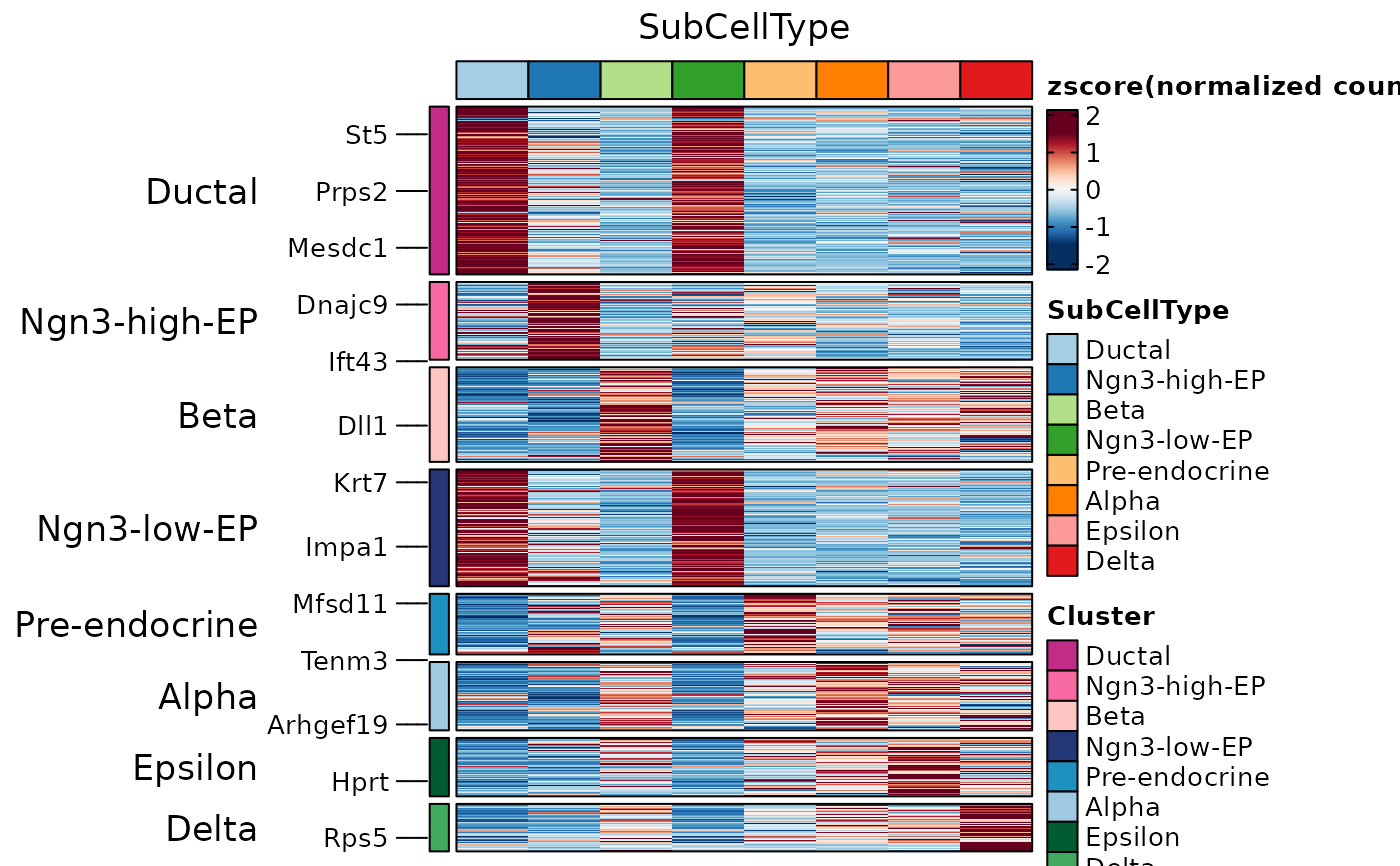 ht3$plot
ht3$plot
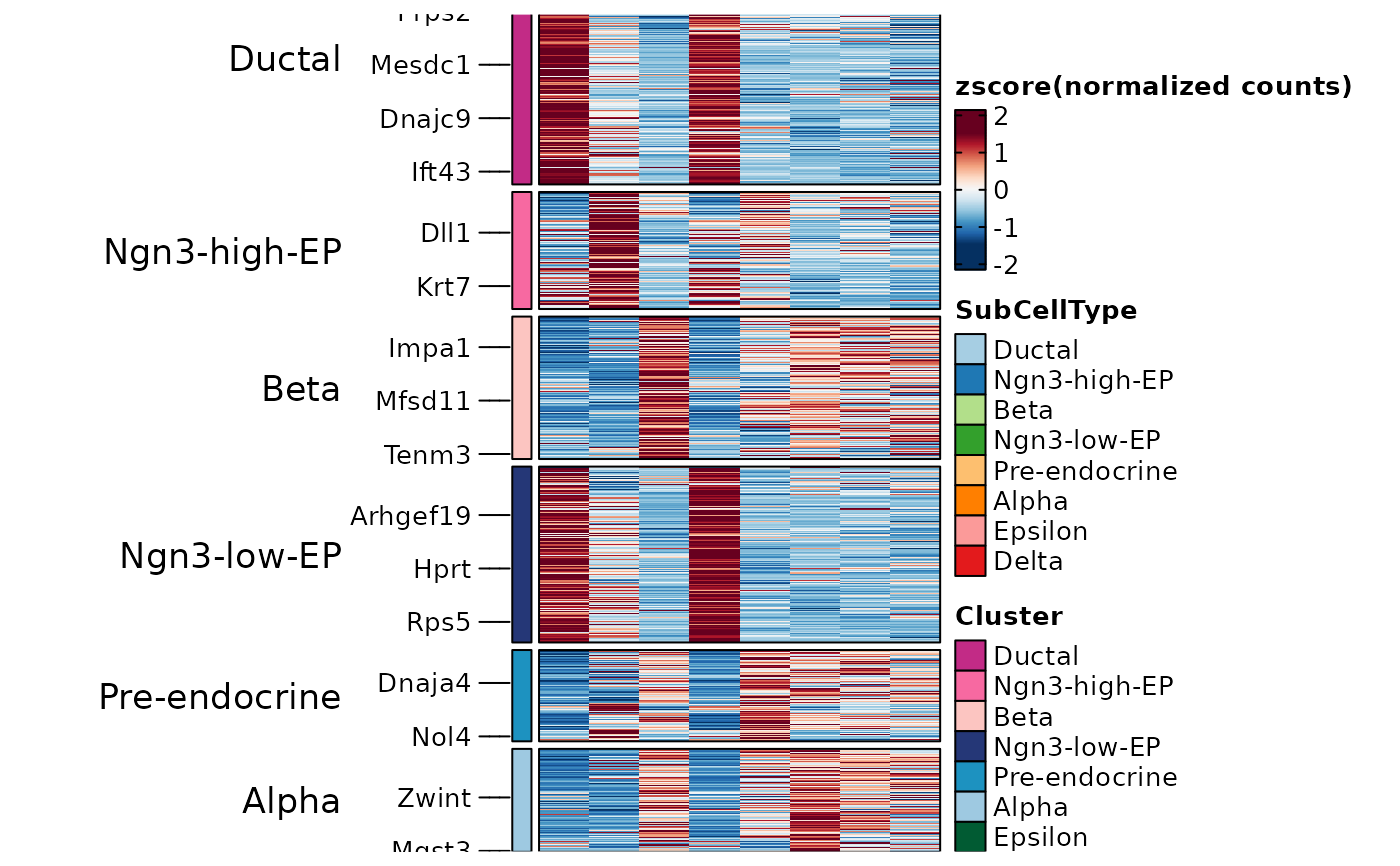 data(panc8_sub)
panc8_sub <- integration_scop(
panc8_sub,
batch = "tech",
integration_method = "Uncorrected"
)
CellDimPlot(
panc8_sub,
group.by = c("celltype", "tech")
)
data(panc8_sub)
panc8_sub <- integration_scop(
panc8_sub,
batch = "tech",
integration_method = "Uncorrected"
)
CellDimPlot(
panc8_sub,
group.by = c("celltype", "tech")
)
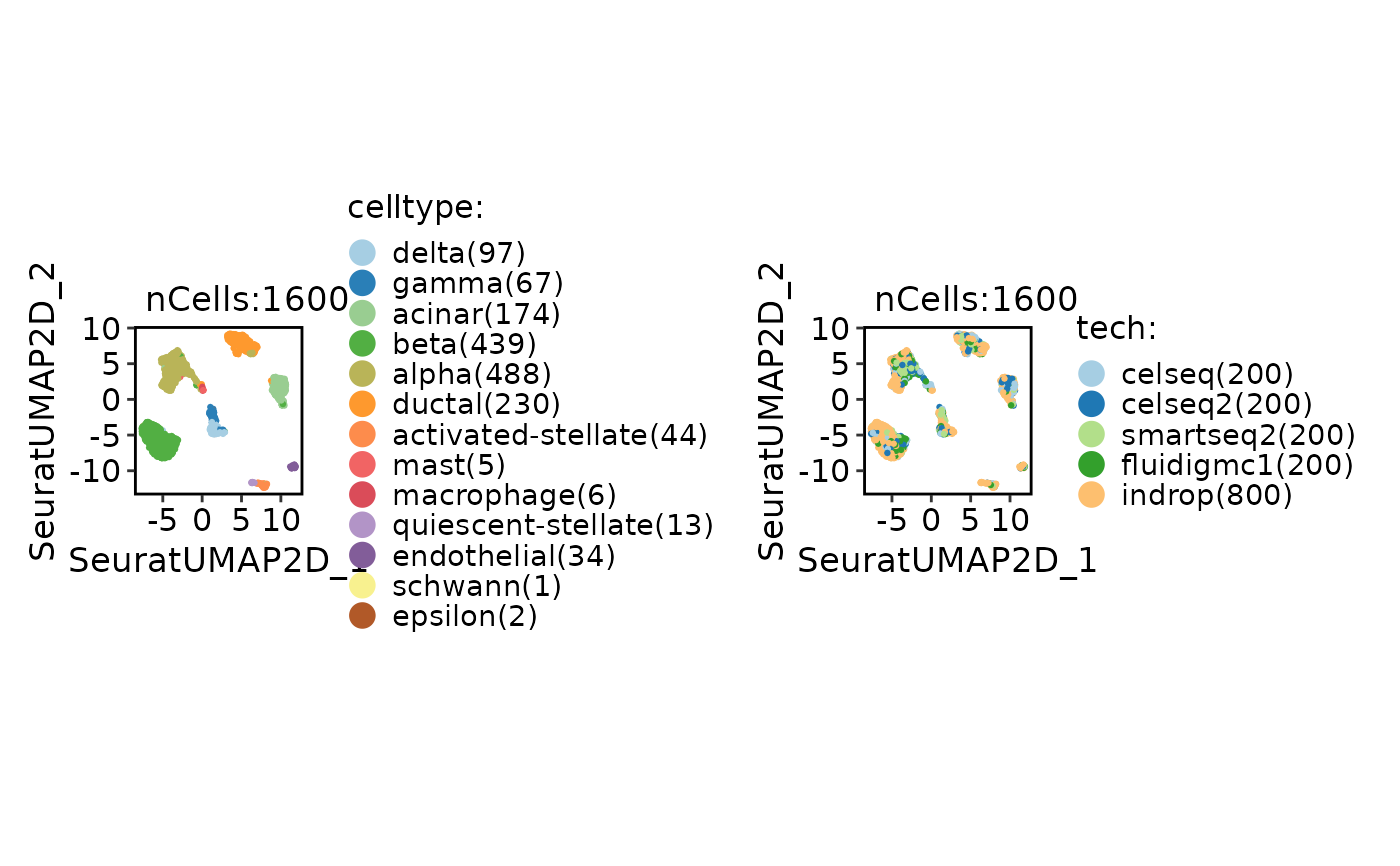 panc8_sub <- RunDEtest(
srt = panc8_sub,
group_by = "celltype",
grouping.var = "tech",
markers_type = "conserved",
cores = 2
)
#> ⠙ [2025-12-05 08:53:28] Running [7/13] Processing: delta, acinar, alpha, activa…
#> ✔ [2025-12-05 08:53:28] Completed 13 tasks in 6.1s
#>
ConservedMarkers1 <- dplyr::filter(
panc8_sub@tools$DEtest_celltype$ConservedMarkers_wilcox,
p_val_adj < 0.05 & avg_log2FC > 1
)
ht4 <- GroupHeatmap(
panc8_sub,
layer = "data",
features = ConservedMarkers1$gene,
feature_split = ConservedMarkers1$group1,
group.by = "tech",
split.by = "celltype",
within_groups = TRUE
)
#> 'magick' package is suggested to install to give better rasterization.
#>
#> Set `ht_opt$message = FALSE` to turn off this message.
#> `use_raster` is automatically set to TRUE for a matrix with more than
#> 2000 rows. You can control `use_raster` argument by explicitly setting
#> TRUE/FALSE to it.
#>
#> Set `ht_opt$message = FALSE` to turn off this message.
#> `use_raster` is automatically set to TRUE for a matrix with more than
#> 2000 rows. You can control `use_raster` argument by explicitly setting
#> TRUE/FALSE to it.
#>
#> Set `ht_opt$message = FALSE` to turn off this message.
panc8_sub <- RunDEtest(
srt = panc8_sub,
group_by = "celltype",
grouping.var = "tech",
markers_type = "conserved",
cores = 2
)
#> ⠙ [2025-12-05 08:53:28] Running [7/13] Processing: delta, acinar, alpha, activa…
#> ✔ [2025-12-05 08:53:28] Completed 13 tasks in 6.1s
#>
ConservedMarkers1 <- dplyr::filter(
panc8_sub@tools$DEtest_celltype$ConservedMarkers_wilcox,
p_val_adj < 0.05 & avg_log2FC > 1
)
ht4 <- GroupHeatmap(
panc8_sub,
layer = "data",
features = ConservedMarkers1$gene,
feature_split = ConservedMarkers1$group1,
group.by = "tech",
split.by = "celltype",
within_groups = TRUE
)
#> 'magick' package is suggested to install to give better rasterization.
#>
#> Set `ht_opt$message = FALSE` to turn off this message.
#> `use_raster` is automatically set to TRUE for a matrix with more than
#> 2000 rows. You can control `use_raster` argument by explicitly setting
#> TRUE/FALSE to it.
#>
#> Set `ht_opt$message = FALSE` to turn off this message.
#> `use_raster` is automatically set to TRUE for a matrix with more than
#> 2000 rows. You can control `use_raster` argument by explicitly setting
#> TRUE/FALSE to it.
#>
#> Set `ht_opt$message = FALSE` to turn off this message.
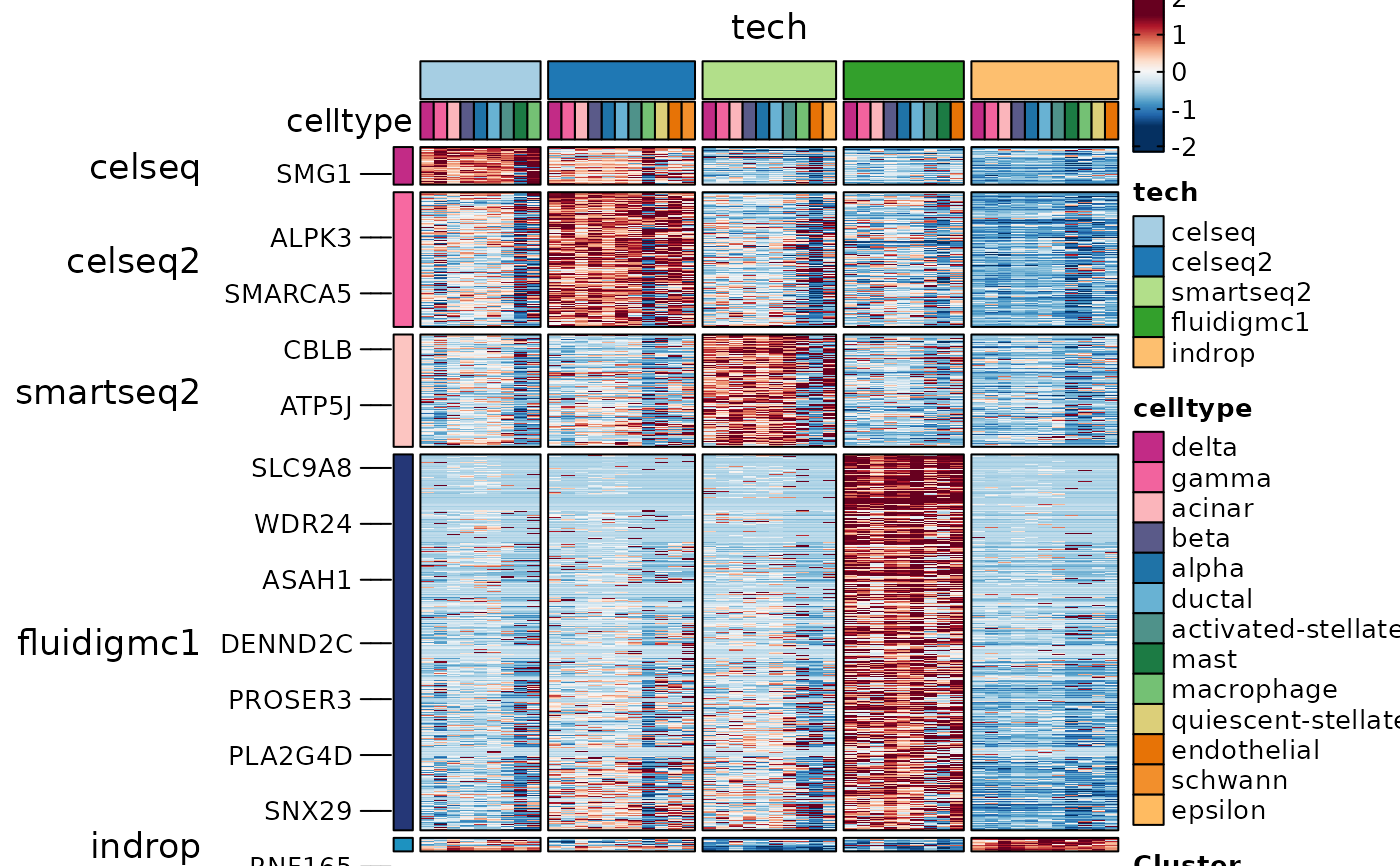 ht4$plot
ht4$plot
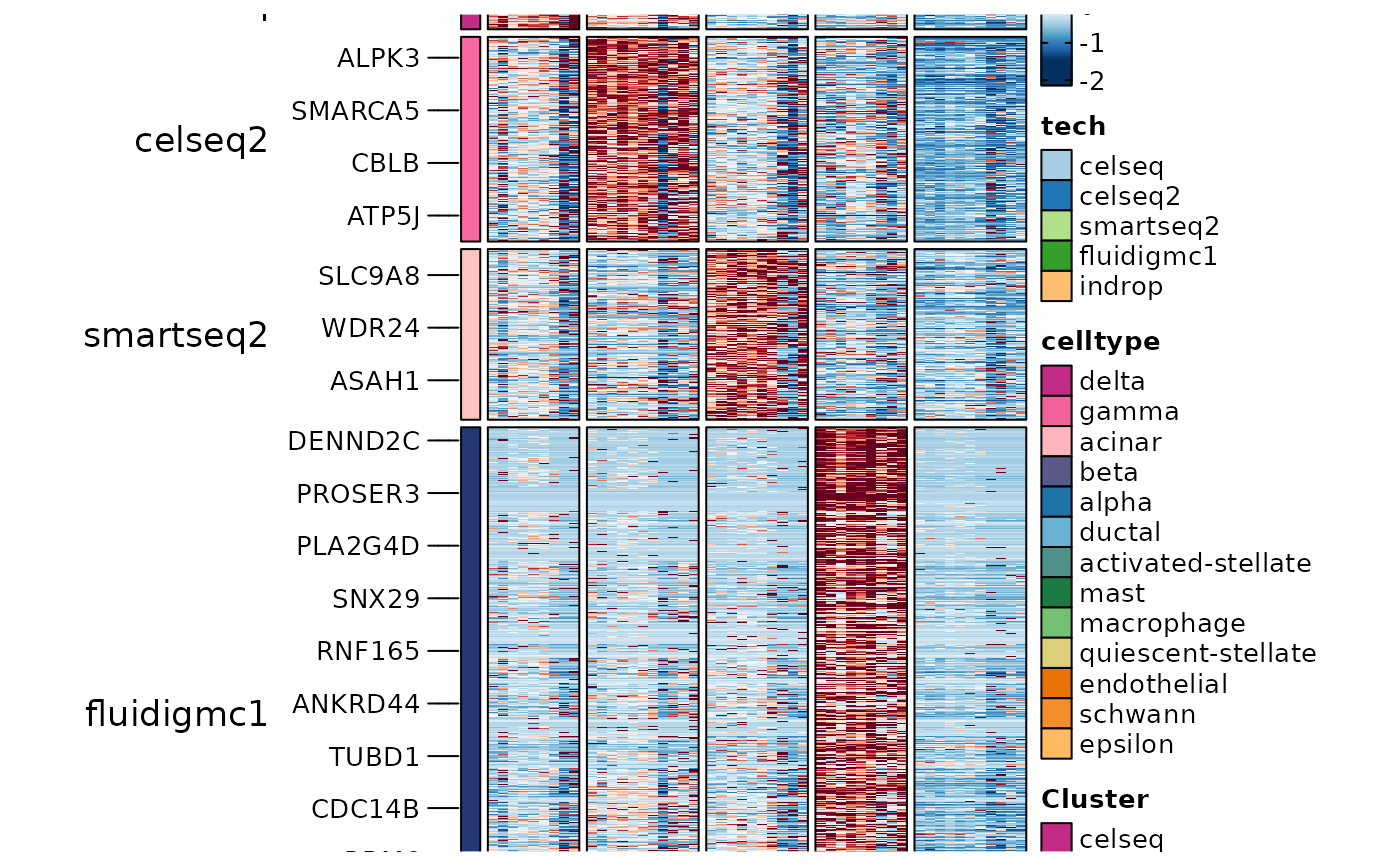 panc8_sub <- RunDEtest(
srt = panc8_sub,
group_by = "tech",
grouping.var = "celltype",
markers_type = "conserved",
cores = 2
)
#> ⠙ [2025-12-05 08:53:53] Running [3/5] Processing: celseq, smartseq2, indrop ET…
#> ✔ [2025-12-05 08:53:53] Completed 5 tasks in 5.3s
#>
ConservedMarkers2 <- dplyr::filter(
panc8_sub@tools$DEtest_tech$ConservedMarkers_wilcox,
p_val_adj < 0.05 & avg_log2FC > 1
)
ht4 <- GroupHeatmap(
srt = panc8_sub,
layer = "data",
features = ConservedMarkers2$gene,
feature_split = ConservedMarkers2$group1,
group.by = "tech",
split.by = "celltype"
)
#> 'magick' package is suggested to install to give better rasterization.
#>
#> Set `ht_opt$message = FALSE` to turn off this message.
panc8_sub <- RunDEtest(
srt = panc8_sub,
group_by = "tech",
grouping.var = "celltype",
markers_type = "conserved",
cores = 2
)
#> ⠙ [2025-12-05 08:53:53] Running [3/5] Processing: celseq, smartseq2, indrop ET…
#> ✔ [2025-12-05 08:53:53] Completed 5 tasks in 5.3s
#>
ConservedMarkers2 <- dplyr::filter(
panc8_sub@tools$DEtest_tech$ConservedMarkers_wilcox,
p_val_adj < 0.05 & avg_log2FC > 1
)
ht4 <- GroupHeatmap(
srt = panc8_sub,
layer = "data",
features = ConservedMarkers2$gene,
feature_split = ConservedMarkers2$group1,
group.by = "tech",
split.by = "celltype"
)
#> 'magick' package is suggested to install to give better rasterization.
#>
#> Set `ht_opt$message = FALSE` to turn off this message.
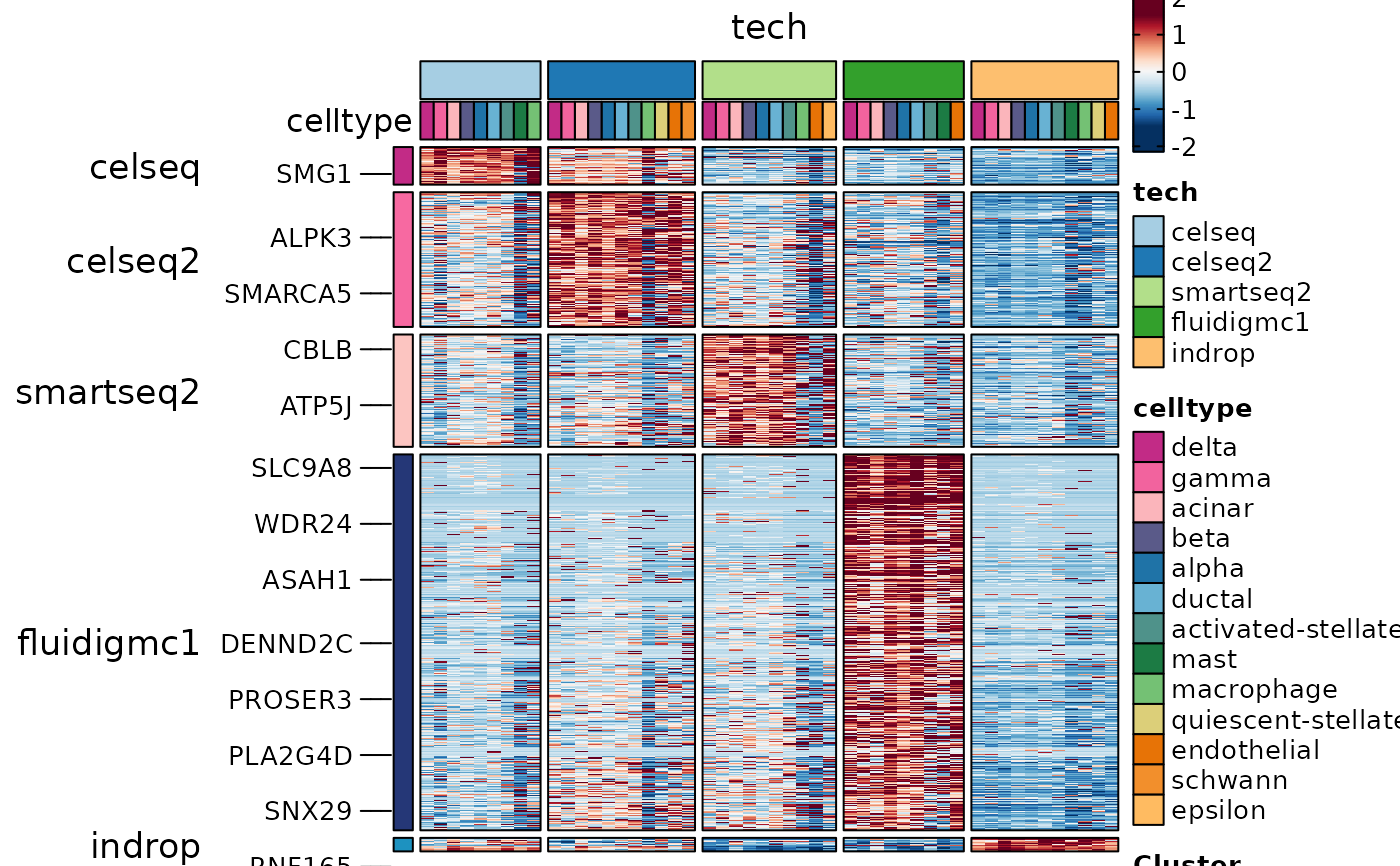 ht4$plot
ht4$plot
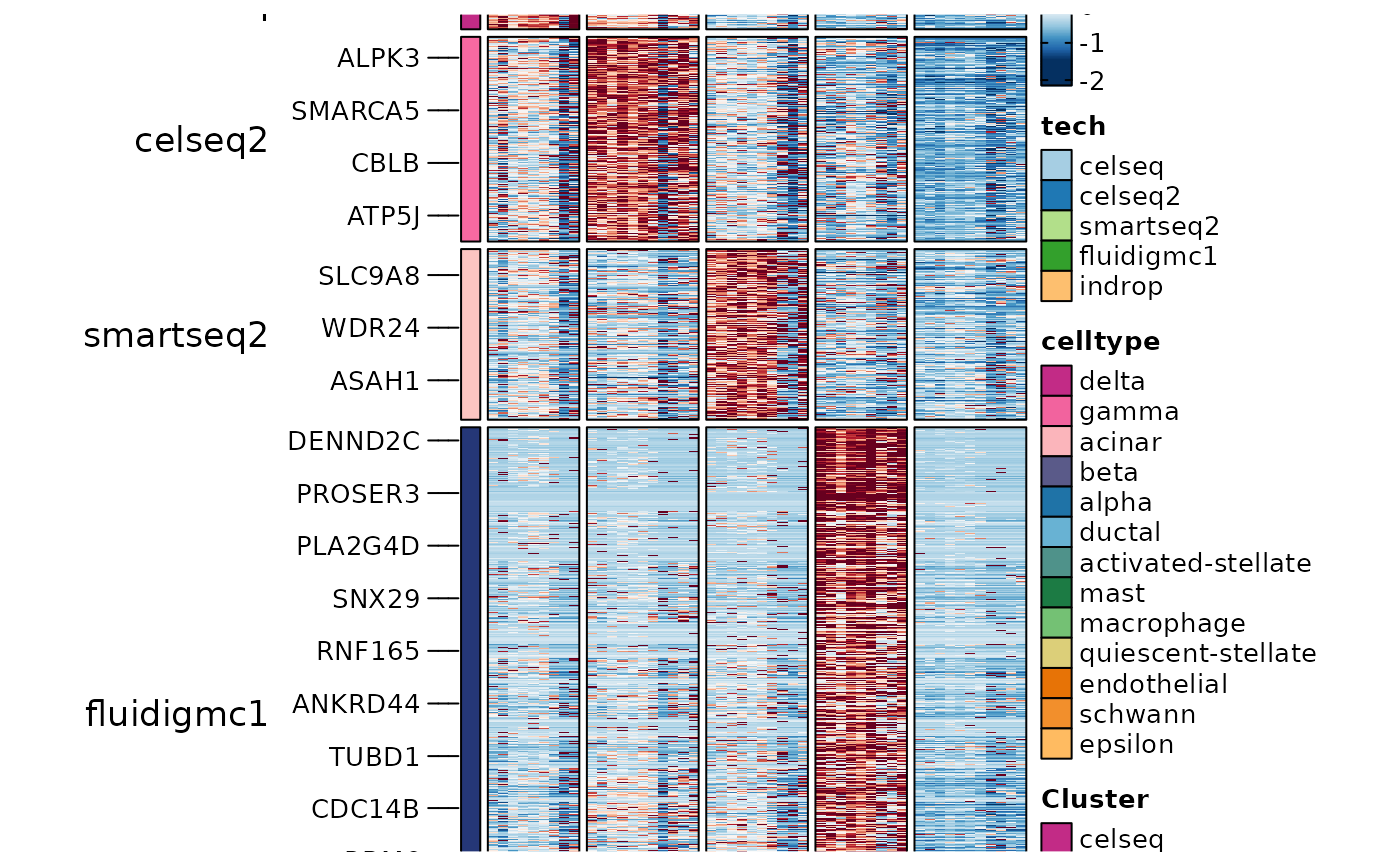 panc8_sub <- RunDEtest(
srt = panc8_sub,
group_by = "celltype",
grouping.var = "tech",
markers_type = "disturbed",
cores = 2
)
#> ⠙ [2025-12-05 08:54:10] Running [7/13] Processing: delta, acinar, alpha, activa…
#> ✔ [2025-12-05 08:54:10] Completed 13 tasks in 12s
#>
DisturbedMarkers <- dplyr::filter(
panc8_sub@tools$DEtest_celltype$DisturbedMarkers_wilcox,
p_val_adj < 0.05 & avg_log2FC > 1 & var1 == "smartseq2"
)
ht5 <- GroupHeatmap(
srt = panc8_sub,
layer = "data",
features = DisturbedMarkers$gene,
feature_split = DisturbedMarkers$group1,
group.by = "celltype",
split.by = "tech"
)
#> 'magick' package is suggested to install to give better rasterization.
#>
#> Set `ht_opt$message = FALSE` to turn off this message.
#> `use_raster` is automatically set to TRUE for a matrix with more than
#> 2000 rows. You can control `use_raster` argument by explicitly setting
#> TRUE/FALSE to it.
#>
#> Set `ht_opt$message = FALSE` to turn off this message.
panc8_sub <- RunDEtest(
srt = panc8_sub,
group_by = "celltype",
grouping.var = "tech",
markers_type = "disturbed",
cores = 2
)
#> ⠙ [2025-12-05 08:54:10] Running [7/13] Processing: delta, acinar, alpha, activa…
#> ✔ [2025-12-05 08:54:10] Completed 13 tasks in 12s
#>
DisturbedMarkers <- dplyr::filter(
panc8_sub@tools$DEtest_celltype$DisturbedMarkers_wilcox,
p_val_adj < 0.05 & avg_log2FC > 1 & var1 == "smartseq2"
)
ht5 <- GroupHeatmap(
srt = panc8_sub,
layer = "data",
features = DisturbedMarkers$gene,
feature_split = DisturbedMarkers$group1,
group.by = "celltype",
split.by = "tech"
)
#> 'magick' package is suggested to install to give better rasterization.
#>
#> Set `ht_opt$message = FALSE` to turn off this message.
#> `use_raster` is automatically set to TRUE for a matrix with more than
#> 2000 rows. You can control `use_raster` argument by explicitly setting
#> TRUE/FALSE to it.
#>
#> Set `ht_opt$message = FALSE` to turn off this message.
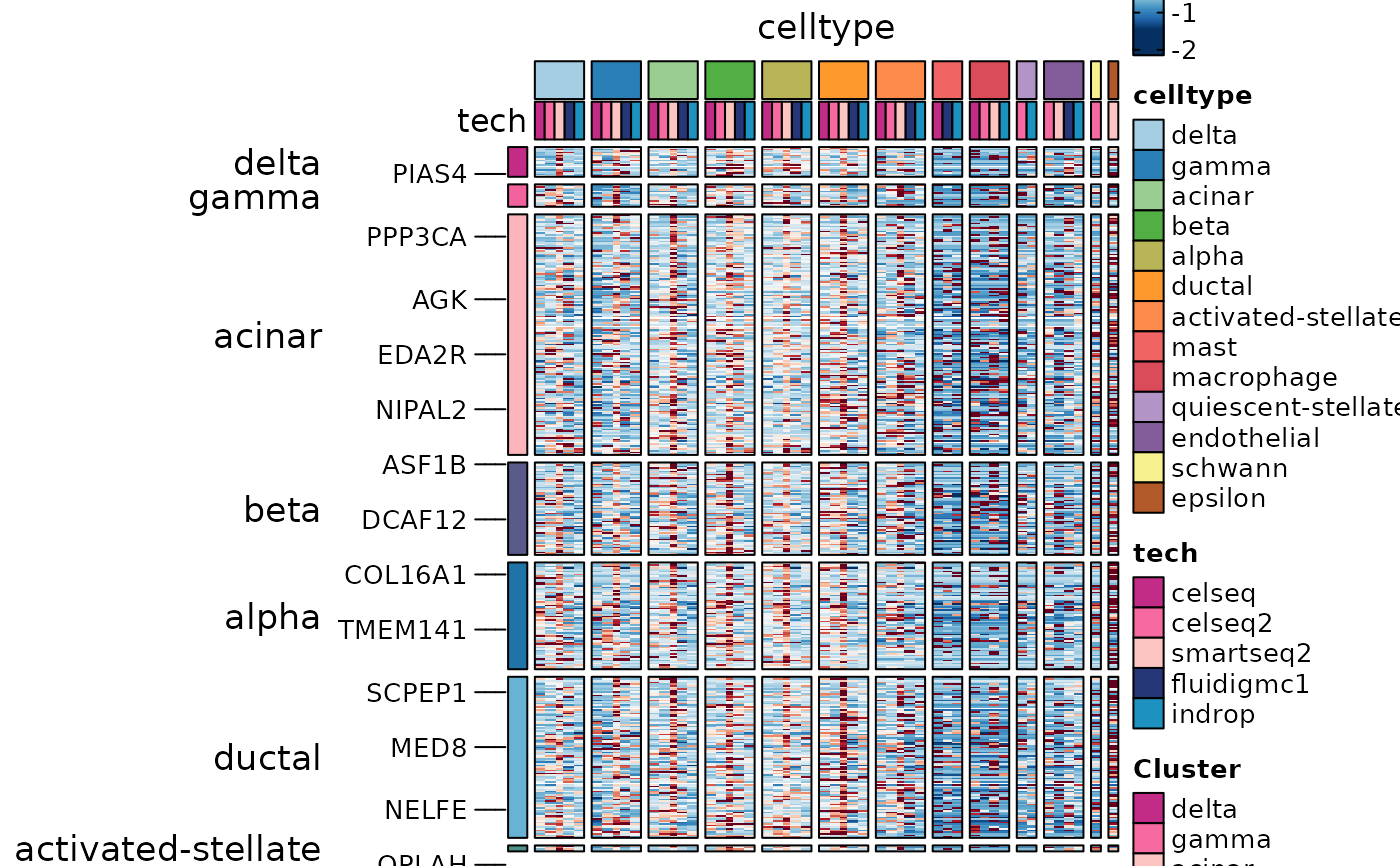 ht5$plot
ht5$plot
 gene_specific <- names(which(table(DisturbedMarkers$gene) == 1))
DisturbedMarkers_specific <- DisturbedMarkers[
DisturbedMarkers$gene %in% gene_specific,
]
ht6 <- GroupHeatmap(
srt = panc8_sub,
layer = "data",
features = DisturbedMarkers_specific$gene,
feature_split = DisturbedMarkers_specific$group1,
group.by = "celltype",
split.by = "tech"
)
#> 'magick' package is suggested to install to give better rasterization.
#>
#> Set `ht_opt$message = FALSE` to turn off this message.
gene_specific <- names(which(table(DisturbedMarkers$gene) == 1))
DisturbedMarkers_specific <- DisturbedMarkers[
DisturbedMarkers$gene %in% gene_specific,
]
ht6 <- GroupHeatmap(
srt = panc8_sub,
layer = "data",
features = DisturbedMarkers_specific$gene,
feature_split = DisturbedMarkers_specific$group1,
group.by = "celltype",
split.by = "tech"
)
#> 'magick' package is suggested to install to give better rasterization.
#>
#> Set `ht_opt$message = FALSE` to turn off this message.
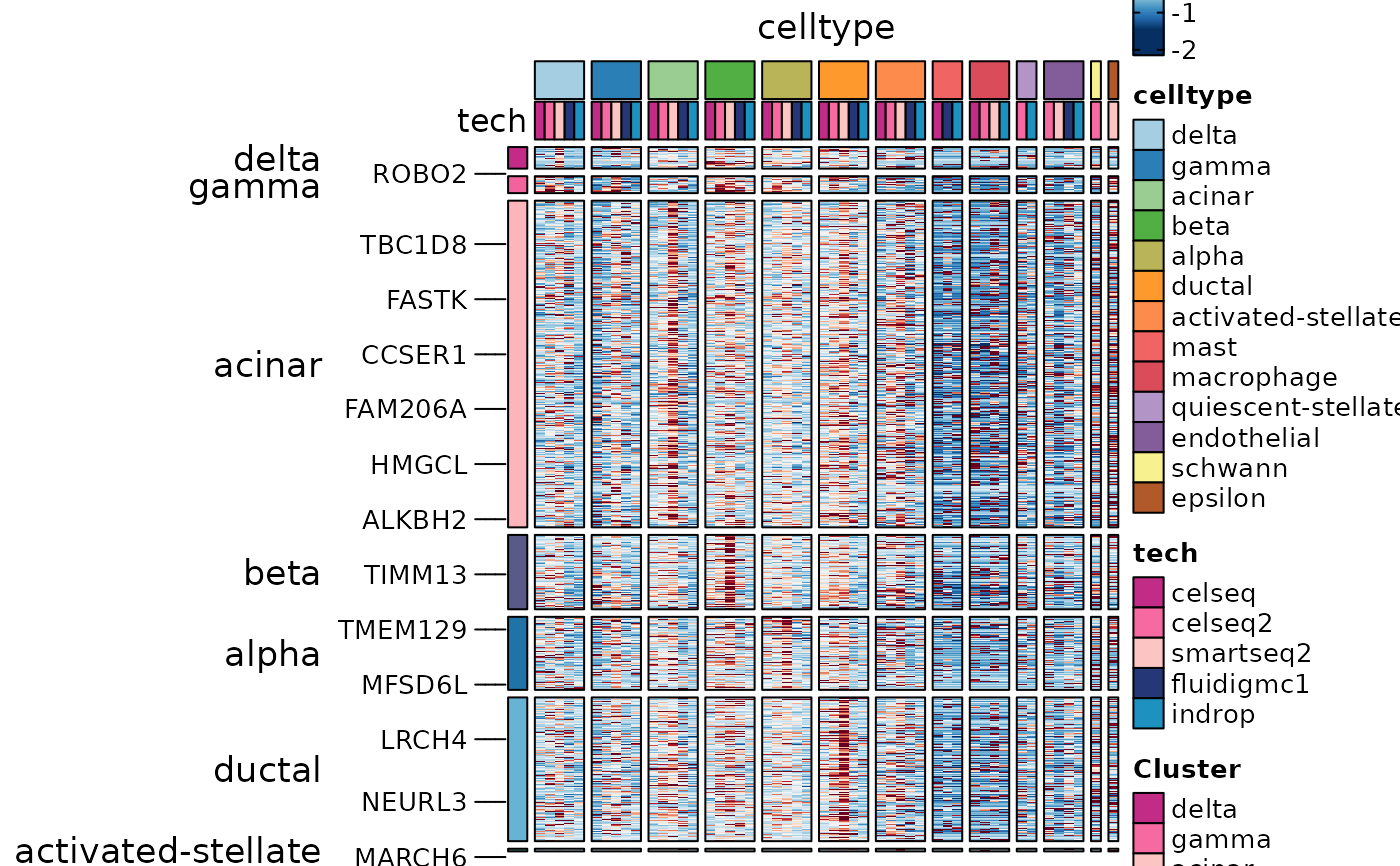 ht6$plot
ht6$plot
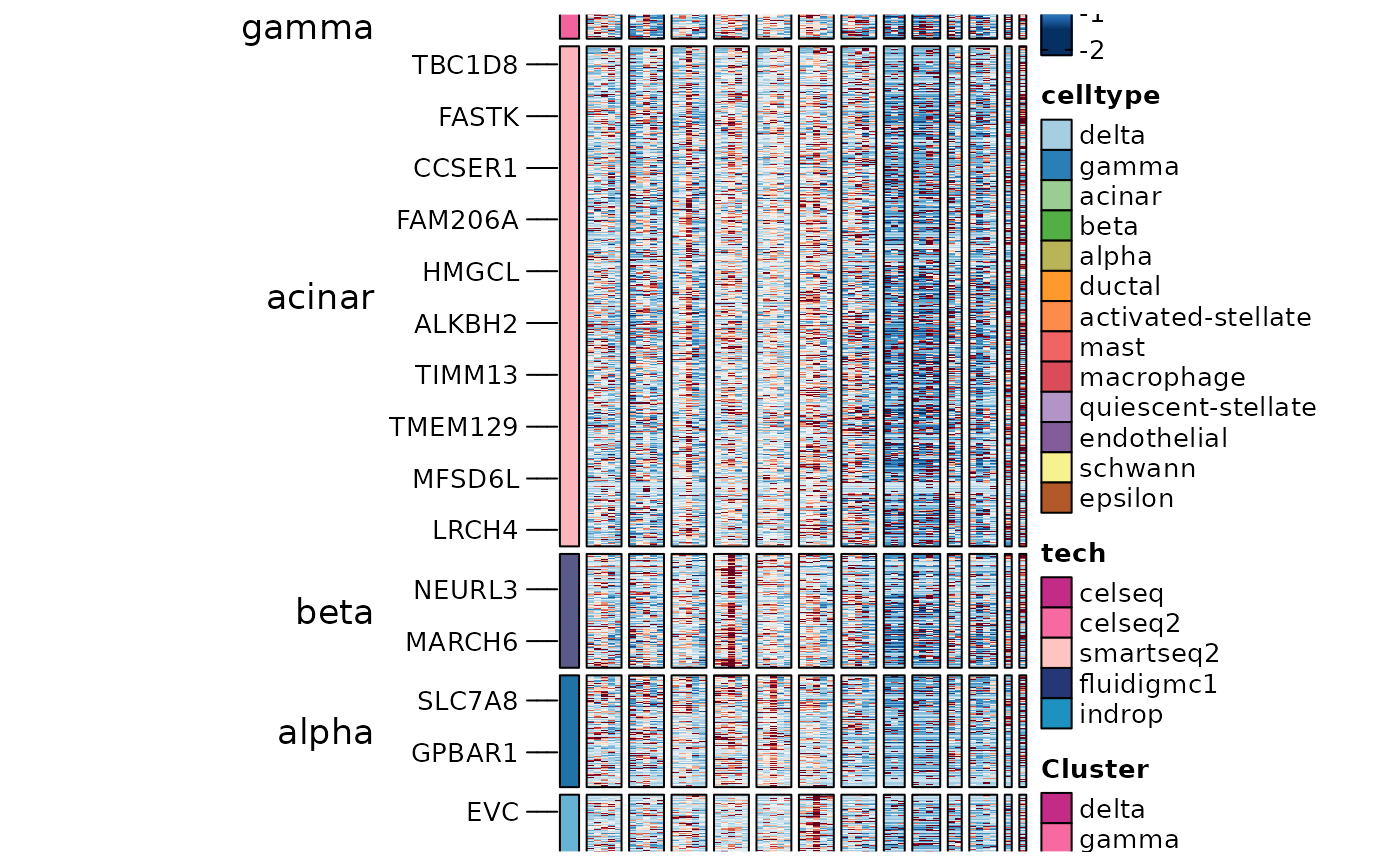 ht7 <- GroupHeatmap(
srt = panc8_sub,
layer = "data",
aggregate_fun = function(x) mean(expm1(x)) + 1,
features = DisturbedMarkers_specific$gene,
feature_split = DisturbedMarkers_specific$group1,
group.by = "celltype",
grouping.var = "tech",
numerator = "smartseq2"
)
#> 'magick' package is suggested to install to give better rasterization.
#>
#> Set `ht_opt$message = FALSE` to turn off this message.
ht7 <- GroupHeatmap(
srt = panc8_sub,
layer = "data",
aggregate_fun = function(x) mean(expm1(x)) + 1,
features = DisturbedMarkers_specific$gene,
feature_split = DisturbedMarkers_specific$group1,
group.by = "celltype",
grouping.var = "tech",
numerator = "smartseq2"
)
#> 'magick' package is suggested to install to give better rasterization.
#>
#> Set `ht_opt$message = FALSE` to turn off this message.
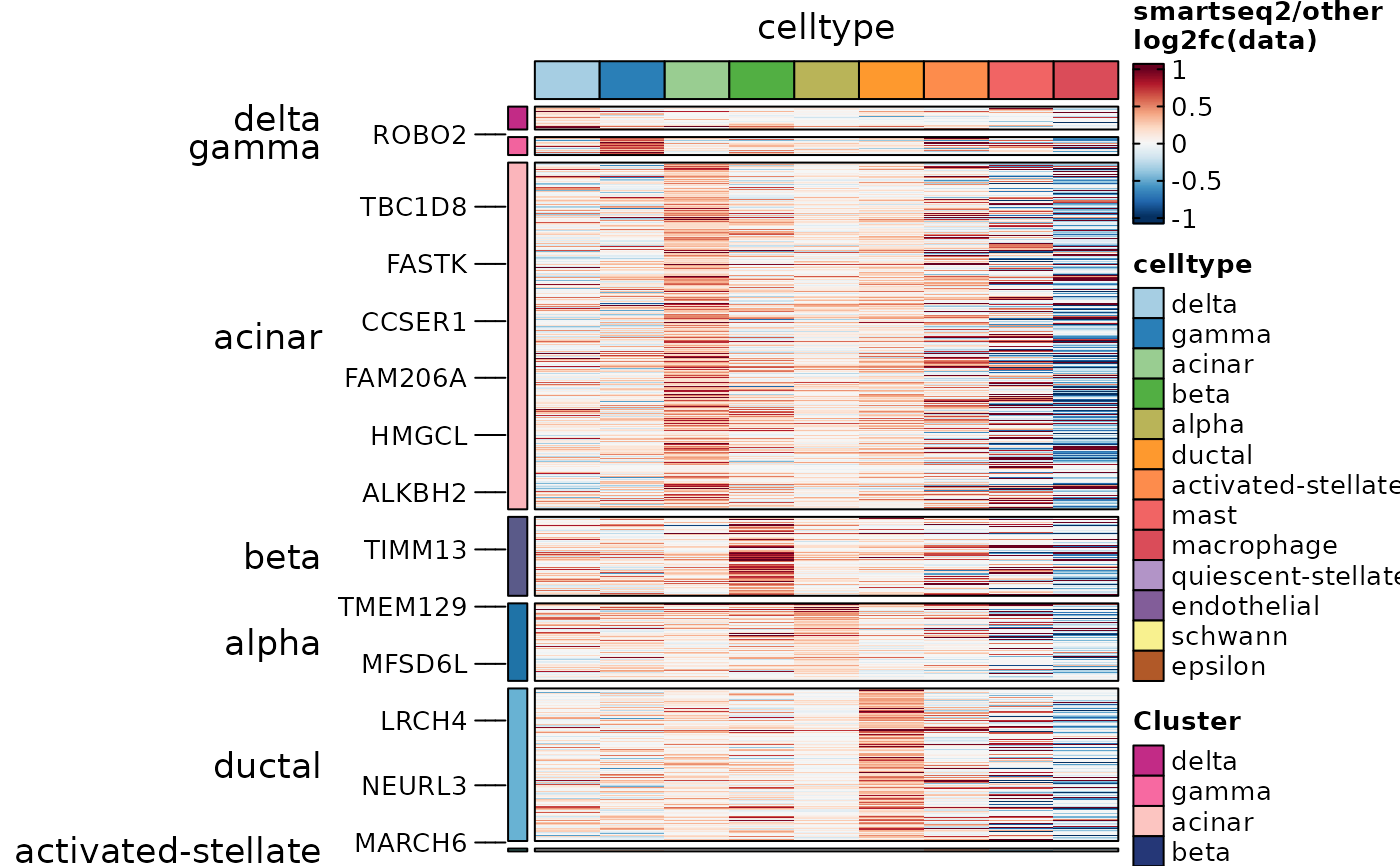 ht7$plot
ht7$plot
